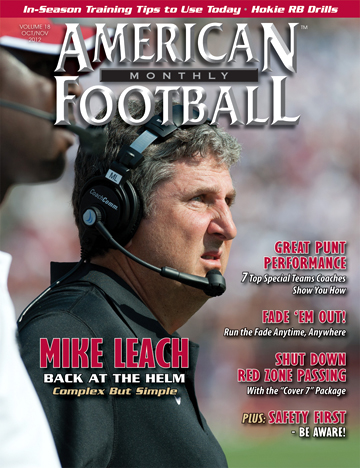RED ZONE COVERAGES AND PHILOSOPHY To shut down a passing attack near the goal line, consider cover 7.
by: Joe KlandermanDefensive Coordinator • Minnesota State University ©
More from this issue
To look at pass defense in the Red Zone, it is important to first identify the different areas of the Red Zone. We typically break the Red Zone into three areas – from the 20-10 yard line, where offenses have the majority of their package intact, from the 10-2 yard line where offenses are somewhat restricted in what they can do in the passing game, and from the 2 to the goal line, where typically bigger personnel groups are brought in and the style of play becomes more goal line/short yardage. Clearly, these zones differ from team to team, and it is up to you as a coordinator to see where these break lines/shifts in tendency occur.
I‘m going to concentrate on the area inside the 10-yard line. Defenses have a tremendous advantage in this area when it comes to defending the pass. The field is condensed, which eliminates some passing routes. And, the increased threat of 0 blitzes by the defense can lead to more conservative play. Another reason a defense has an advantage is that, given the condensed field, more aggressive coverages can be played. In zone, passing “windows” are smaller, and because of the absence of a vertical passing game, players can take significantly more risks than they typically would. We have used a number of schemes in this area. During the 2011 season, we held opponents to a completion percentage of 12% in the Red Zone.
Cover 7, as we call it, is something that has its own mentality. By that, when you consider run fits and normal drop rules, it is not a condensed version of cover 2, which is popular, nor is it an aggressive cover 4. It takes players time to understand and adjust to this mentality, which is outside of their typical rules. However, it is very easy to teach and can be used vs. any formation or personnel group.
There are three things that you must consider before talking about cover 7 rules. First is when and where you use this coverage. Because all players will be required to carry verticals, we typically do not extend this coverage beyond the 10-yard line. There have been occasions where we have been on the 12 plus that we have used it, but it was because we were comfortable with the route concepts that we thought we were going to see, and comfortable with the athleticism of our personnel to get the job done. Second, you want to make sure that you are gap sound in the run game. The one thing you must be sure of is that you eliminate the use of any conflicted players. That is, players that are involved in the run fit yet have immediate pass drop responsibilities. That may be something that you can do with your front, or something you need to use line movement to accomplish, but the last thing you want with your back against the wall are tentative, unsure players. Finally, you have to consider pre-snap looks that you may want to give before jumping into this coverage. It is pretty easy to marry up this coverage with looks of other things that you may do in this area of the field. Getting into this coverage out of something that looks like a 0 blitz is what we do frequently.
Here is our base alignment vs. a 2 X 2 set and a 3 X 1 set – Diagrams 1 and 2.
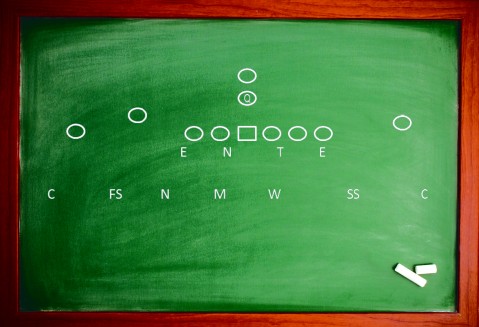
Diagram 1: Vs. a 2 X 2 Set
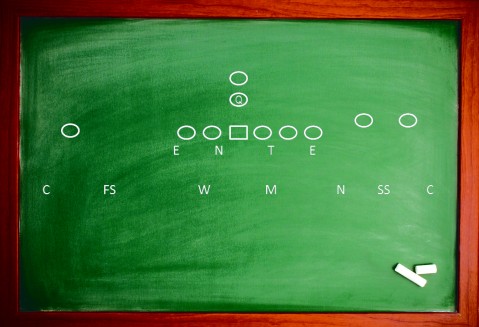
Diagram 2: Vs. a 3 X 1 Set
Rules:
Corners
Alignment - The corner’s ideal alignment is a body width outside of the # 1 receiver, although his alignment could vary depending upon the split of the # 1 receiver. The tighter the # 1 gets to the line of scrimmage, the wider his alignment will become, and the wider the split of the # 1 receiver, the tighter the split of the corner will be in relation to him, to the point of being inside eye to outside eye on him.
Assignment - The corner is responsible for the outside/fade release of # 1. Because of his alignment, a receiver should have a difficult time creating space with a fade release. If the corner does not get the outside release of # 1, he will be responsible for anything out, deep to short. He should not back up but make the receiver take the corner to depth.
Safeties
Alignment - The safeties will split the difference between the # 1 and # 2 WR.
Assignment - The safeties will be responsible for the inside release of # 1. If the # 1 receiver releases anywhere inside the corner, the safety will wall him to the back of the end zone (low and inside). If the # 1 receiver does not inside release, then the safety will play on the outside tip of # 2, and be responsible for anything out, deep to short.
Nickel / Will
Alignment - The seam players will align between the # 2 and # 3 receiver.
Assignment - The seam players are responsible for the inside release of the # 2s. If the #2 receiver releases inside the safety, the seam player will wall him to the back of the end zone. If the #2 receiver releases outside of the safety, the seam players will play outside of #3 and off the QB intentions. Because of the nature of this defense, there should never be anything coming in to them. All threats after the pattern distribution should be coming from inside.
Mike
Alignment - In relation to #3.
Assignment - The Mike will be responsible for the inside release of #3. If the #3 releases inside of the seam player, the Mike will wall him to the back of the end zone. If the #3 receiver releases outside of the seam player, or does not release, then the Mike plays off the QB’s intentions.
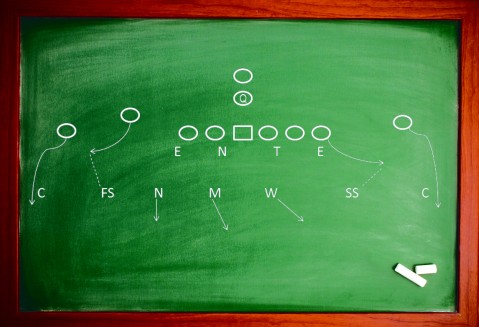
Diagram 3
Diagram 3 shows alignment vs. some Red Zone combinations out/seam.
Per the rules, the outside release of #1 will get matched by the corner. The corner should widen his relase and reduce the WR’s space on the sideline. Because there was an outside release of #1, the safeties can now match the #2s. Nickel, Mike and Will can play off the QB intentions and are all able to pull up the QB on second containment, if necessary.
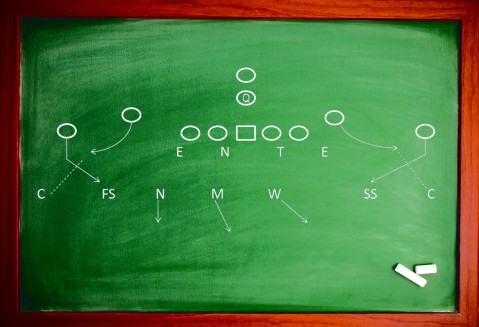
Diagram 4
Diagram 4 shows alignment vs. the flat/slant pass.
Because of the inside release of the #1, the safeties will match, collision and carry them through. The corners, also because of the inside release of #1, are now going to open and look for anything coming out. When they see the out release of #2, they will match it. Nickel, Mike and Will can play off the QB intentions and are able to pull up the QB on second contain, if necessary.
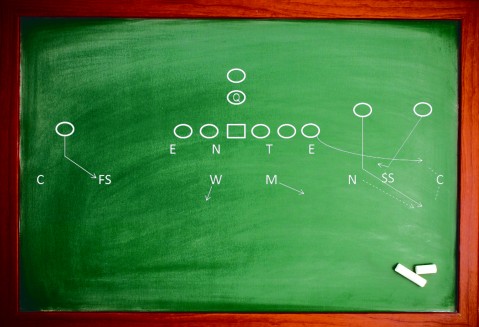
Diagram 5
Diagram 5 shows alignment vs. the spot pass.
The strong safety is getting the inside release of #1, so he will cancel and carry it. The nickel is getting an inside release of #2, so per his rules, he will match and carry it. The corner is getting an inside release of #1, so he is looking for anything out, deep to short. Because the field is condensed, he will be able to play off the QB and match either the corner route by #2, or the out by #3. On the other side of the field, an inside release by #1 dictates that the FS will match, collision and carry it through. The Mike, Will and left corner can play off the QB intentions and are able to pull up the QB on second containment, if necessary.
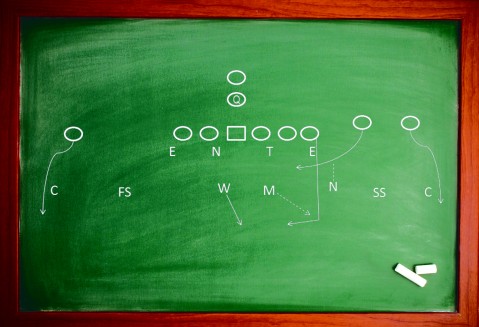
Diagram 6
Diagram 6 shows alignment vs. the hi/lo pass.
With the outside releases of the #1s, the corners will widen and match them. Given the inside release of the #2, the nickel will cancel and carry it. In cover 7, we believe it is all right to step up to cancel a route where in most other coverages this would be a no cover zone. With the inside release of #3, the Mike will relate to it and carry it through. The FS, the Will, and the SS will all play off the QB intentions and, again, are able to pull the QB up on second containment, if necessary.
About the Author: Joe Klanderman enters his 16th season at Minnesota State this fall. A defensive lineman there from 1997-2001, he became an assistant coach after graduation and is now in his sixth season as Defensive Coordinator. Klanderman holds both a Bachelor’s Degree and Master’s from Minnesota State.
